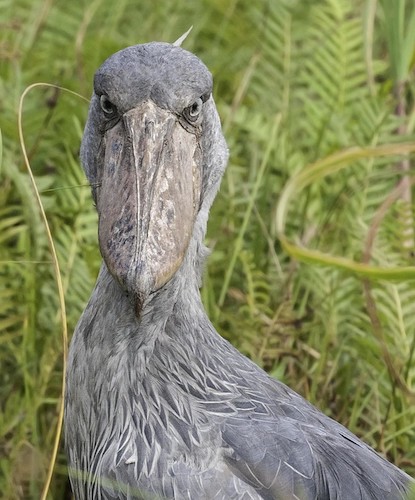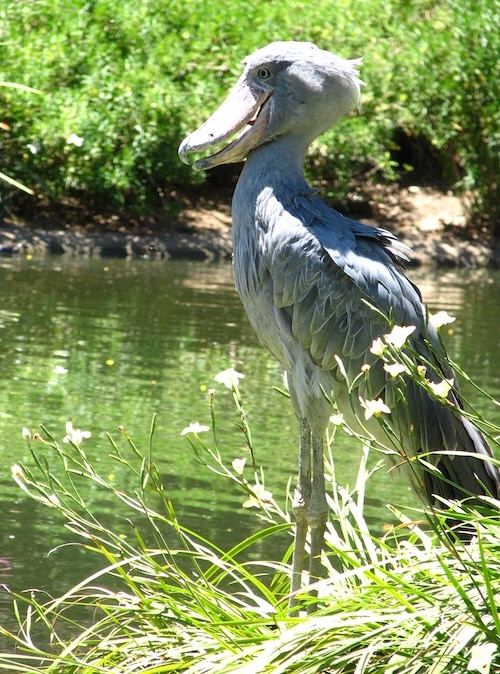Balaenicipitidae – Shoebill

The Shoebill Balaeniceps rex also known as whalehead or shoe-billed stork, is a very large stork-like bird. It derives its name from its massive shoe-shaped bill. Although it has a somewhat stork-like overall form and has previously been classified in the order Ciconiiformes, its true affiliations with other living birds is ambiguous. Most authorities now reclassify it with the Pelecaniformes along with Threskiornithidae (Ibises & Spoonbills), Scopidae (Hamerkop) and Pelecanidae (Pelicans).
The shoebill is distributed in freshwater swamps of central tropical Africa, from southern Sudan through parts of eastern Congo, Rwanda, Uganda, western Tanzania and northern Zambia. The species is most numerous in the West Nile sub-region and adjacent areas of South Sudan; it is also significant in wetlands of Uganda and western Tanzania. More isolated records have been reported of shoebills in Kenya, the Central African Republic, northern Cameroon, south-western Ethiopia, Malawi. Vagrant strays to the Okavango Basin, Botswana and the upper Congo River have also been sighted. The distribution of this species seems to largely coincide with that of papyrus and lungfish. The shoebill is non-migratory with limited seasonal movements due to habitat changes, food availability and disturbance by humans.
It occurs in extensive, dense freshwater marshes. Almost all wetlands that attract the species have undisturbed Cyperus papyrus and reed beds of Phragmites and Typha. Although their distribution largely seems to correspond with the distribution of papyrus in central Africa, the species seems to avoid pure papyrus swamps and is often attracted to areas with mixed vegetation. More rarely, the species has been seen foraging in rice fields and flooded plantations.
The solitary nature of shoebills extends to their breeding habits. Nests typically occur at less than three nests per square kilometre, unlike herons, cormorants, pelicans and storks, which predominantly nest in colonies. The breeding pair of shoebills vigorously defends a territory. Both parents actively brood, shade, guard and feed the nestling, though the females are perhaps slightly more attentive. Food items are regurgitated whole from the gullet straight into the bill of the young. Shoebills rarely raise more than one chick, but will hatch more. The younger chicks are intended as back-ups in case the eldest dies or is weak. Fledging is reached at around 105 days and the young birds can fly well by 112 days. However, they are still fed for possibly a month or more after this. It will take the young shoebills three years before they become fully sexually mature.

Shoebill Balaeniceps rex – ©Parkerman & Christie CC BY 2.0 via Wikimedia Commons
It is a tall bird, with a typical height range of 110cm to 140cm and some specimens reaching as much as 152cm. Its length from tail to beak can range from 100cm to 140cm and its wingspan is 230cm to 260cm. The weight has reportedly ranged from 4kg to 7kg. A male will weigh on average around 5.6kg and is larger than a typical female of 4.9kg. The signature feature of the species is its huge, bulbous bill, which is straw-coloured with erratic greyish markings. The adult is mainly grey while the juveniles are browner.
The exposed culmen (or the measurement along the top of the upper mandible) is 18.8cm to 24cm. The sharp edges in the mandibles help the shoebill to decapitate their prey and also to discard any vegetation after prey has been caught. As in the pelicans, the upper mandible is strongly keeled, ending in a sharp nail. The dark coloured legs are fairly long. The shoebill’s feet are exceptionally large, with the middle toe reaching 16.8cm to 18.5cm in length, likely assisting the species in its ability to stand on aquatic vegetation while hunting. The neck is relatively shorter and thicker than other long-legged wading birds such as herons and cranes. The wings are broad, with a wing chord length of 58.8cm to 78cm and well-adapted to soaring.
The plumage of adult birds is blue-grey with darker slaty-grey flight feathers. The breast presents some elongated feathers, which have dark shafts. The juvenile has a similar plumage colour, but is a darker grey with a brown tinge. When they are first born, shoebills have a more modestly-sized bill, which is initially silvery-grey. The bill becomes more noticeably large when the chicks are 23 days old and becomes well developed by 43 days.
-
Number of bird species: 1
(As at August 2025)
The Balaenicipitidae is a family of just one monotypical species in one genus. Which is:
Shoebill (Whalehead) Balaeniceps rex
-
Pelicans, Cormorants and their Relatives - The Pelecaniformes
| By J Bryan Nelson, John Busby, Andrew Mackay & Bas Teunis | OUP | 2006 | Hardback | 661 pages, 12 col plates, 159 b/w illus, 62 maps | ISBN: 9780198577270 Buy this book from NHBS.com
-
Shoebill Balaeniceps rex
Species AccountThe shoebill (Balaeniceps rex) also known as whalehead or shoe-billed stork, is a very large stork-like bird. It derives its name from its massive shoe-shaped bill. Although it has a somewhat stork-like overall form and has previously been classified in the order Ciconiiformes, its true affiliations with other living birds is ambiguous. Some authorities now reclassify it with the Pelecaniformes. -
Shoebill Balaeniceps rex
Species AccountShoebills are large, prehistoric-looking birds which haunt freshwater marshes and swamps in East Africa... -
Shoebill Balaeniceps rex
Species AccountThis large waterbird is unmistakable due to its unique ‘shoe-shaped’ bill which gives it an almost prehistoric appearance... -
Shoebill Balaeniceps rex
Species AccountSound archive and distribution map.
-
Shoebill Balaeniceps rex
GalleryExcellent image
